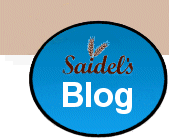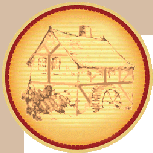by Les Saidel - February, 2011
In a previous article I have explained the difference between natural sourdough yeast and commercial yeast.
In a nutshell to bring you up to speed, natural sourdough yeasts abound in nature all around us, in the air, on our skin, on fruits etc. There are many different strains and species, many indigenous to specific areas in the world. Commercial yeast on the other hand, is a specific strain of yeast that has been genetically isolated and perpetuated in its pure form. Unlike natural yeast, commercial yeast is more highly concentrated allowing the dough to ferment faster. Natural sourdough yeast however, because of its slower fermentation rate, adds complexity of flavour to the dough. A natural, wild sourdough yeast culture is a symbiotic combination of a yeast and a lactobacillus bacteria.
As mentioned on our website, Saidels Bakery has obtained a number of rare wild yeast cultures and as promised in a previous article, here is the story behind these cultures.
Theoretically you could "capture" your own wild yeast culture by leaving an open bowl of water mixed with flour (covered with a cheesecloth to exclude bugs), on a shaded window ledge or doorstep. After 3-4 days the mixture will be invaded by the wild yeast and bacteria occuring naturally in the air. If you have extraordinary luck, you will manage to capture a perfect combination of friendly yeast and lactobacillus bacteria. In practise though, this only occurs 10% of the time. In the other 90% of the cases the mixture is usually invaded by unfriendly and unwanted bacteria. The simple way to ascertain whether the culture you are growing is "friendly" and can be used to ferment dough, or "unfriendly", and potentially harmful to your health, is by the smell. If the smell is a sweetish, nutty smell, remiscent of regular commercial bread yeast, you have struck gold. If the smell is bad, off-putting, you have had bad luck.
After numerous unsuccessful attempts at capturing my own wild yeast culture, I turned to an expert.
Dr. Ed Wood, a retired American pathologist, now residing in the USA, served for many years as the head of the pathology department in the US military hospital in Riyadh, Saudi Arabia. During this time he developed an obsession with wild sourdough yeast cultures. His proximity to Europe and the nature of his work resulted in many trips to various countries in Europe and the Middle East. On each of these trips he made a point of seeking out the old fashioned bakeries, the ones that baked with the "old methods" and set about obtaining a piece of dough from them. He then transported these parcels of dough back to his laboratory where he isolated, identified and perpetuated them.
In his book Classic Sourdoughs, he describes his many escapades, both in obtaining the highly sought after clumps of dough and getting them back to his lab in Riyadh.
For example he describes how he obtained a piece of sourdough in Paris, France. French bakers are fanatically protective of their baking secrets and any "overt" attempt to obtain a piece of dough would be doomed to failure. French bakers are perfectly willing to sell you a baked bread, but a raw piece of dough, that is next to impossible. Only by undertaking a "covert" operation of bribing a taxi driver cousin of a baker in the back streets of Paris, did he finally obtain his stash. Even more interesting is what happened when he tried to "smuggle" the dough back into Saudi Arabia. Customs officials there are fanatical about contraband - drugs, alcohol, pornography etc. The piece of dough, which he unwittingly wrapped in aluminum foil to keep fresh, tripped the metal detectors at the airport. He was frantically trying to explain away a piece of smelly, fermeting dough, wrapped in foil to an airport official who did not speak English, was on high alert against chemical warfare substances and who officated in a country where cutting hands off thieves is common practice. Luckily for him, the person behind him was discovered with a bottle of Chivas Regal in his luggage and all attention was diverted away from him and he was quickly ushered through.
He has similarly fascinating stories about all the cultures he has collected. I will not repeat them here as they are beyond the scope of this article. If you would like to hear about them, email me and I'll tell you, or purchase Ed's highly interesting book (you can order it on Amazon).
The common denominator of all Dr. Wood's cultures is that they were all obtained from "old-world" style bakeries that have been using them for generations. They have stood the test of time and continue to perform as efficiently today as they did decades or even centuries ago. After returning them to his laboratory in Riyadh and after that back to the USA, Ed began experimenting with different methods of freeze drying and shipping his cultures. Once he perfected a fool proof method, he opened up an internet business called Sourdoughs International and began shipping them worldwide. That is how I found him.
Years before we opened our bakery I ordered a number of these yeast cultures and began experimenting with baking with sourdough. It is quite incredible and a little frightening that only a few years after 9/11, when authorities world wide are on the alert for chemical warfare via the postal service, such as anthrax, that I managed to simply order sachets containing live microorganisms by mail order, without any security or even customs examination of the parcel. The parcel arrived intact and unopened. It makes one wonder about our "airtight" security!
An interesting aspect of using these cultures was how I had to "kasher" them for use. Halachically, yeast and bacteria are kosher. They are not considred "shratzim" as they are microscopic and they are pareve, being neither milk or meat. The problem is that they arrived in sachets containing these yeast/bacteria cells combined with freeze dried dough (flour and water). After asking a Rav - who referred me to an local expert in microbiology who is also a talmid chacham, we all managed to come up with a novel way to separate the organisms from the flour/water particles (since Sourdough International is not under OU supervision, and although they use OU certified flour, the flour was unsifted and could possibly have contained "shratzim"). The psak was to place the dried dough on a paper coffee filter and pour tap water over it and collect the drops of liquid that filtered through the coffee filter paper. The theory is that the microorganisms combined with the water and filtered through the paper, but the macroscopic particles of flour (and anything else) remained behind. After this filtering ,the resulting solution was diluted numerous times so that even if a particle of flour did manage to slip through, it would be less than 1 in 60 of the total content. This now "kosher" solution was fed badatz sifted flour which the yeast bacteria began to feed on and I thus reactivated the culture. Since that time, the same cultures have been diluted thousands of times so there is no possibility of any suspicion at all and the cultures are fully mehadrin certified.
I keep these cultures separate, each in its own container, very carefully preventing cross contamination (one culture contaminating another). There are a number of amazing things about sourdough cultures. Firstlly the multifaceted symbiotic relationship between the wild yeast and the lactobacillus bacteria - it is a match made in heaven in so many respects (the scope of which are beyond this article)This "colony" is extremely resilient to outside invasion from other microorganisms, due mainly to its high acidity level but also due to an undefinable natural balance between that specific yeast strain and that specific lactobacillus strain that they crowd everything else out. Perhaps the most amazing thing about sourdough cultures is that, unlike a sachet of commercial yeast which can only create one dough, the same quantity of sourdough yeast may create an unlimited amount of doughs, for the lifetime of the baker (and beyond).
These cultures are like my pets. Like pets, they need regular feeding. Luckily their food requirements are simple, flour and water. They don't need to be taken out for walks and they don't mess, in short - the perfect pet.
To perpetuate the culture you need to feed them every day, depending on the weather, sometimes more than once. If you need to go away for a few days and will not be able to feed them (like on Pesach) you must refrigerate them. This sends the cultures into a state of dormancy. When removed from refrigeration they need to be reactivated by feeding once again to restore them to their highly active state.
We have several different cultures, from Saudi Arabia, San Francisco (yes, the authentic San Francisco Sourdough culture), France, Italy, Austria, South Africa and Russia. Each of these cultures is a different strain of yeast and their resulting behaviour (and flavours) are slightly different. Some ferment faster than others and some are more acidic and some more mild.
When using these wild yeast cultures, it is an enthralling thought that the Egyptian woman who, according to legend, first discovered sourdough accidentally on the banks of the Nile thousands of years ago when a dough was inadvertently left overnight, was baking the same way that I bake today, many thousands of years later.
Some things improve with time and some remain unchanged because there is no improving on G-d's perfection.
Les Saidel
© Copyright. All rights in the above articles are reserved to the author Les Saidel.
No part of this website or the above articles may be transmitted in any form or by any
means without permission in writing from the author.




